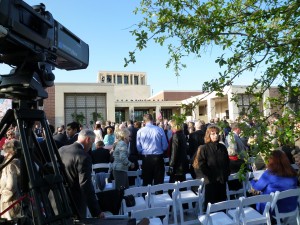 Since I was on the design committee that advised Laura Bush on the George W. Bush presidential library, I am not in a position to offer an objective review of the architecture of the building. You will have to make up your own mind. I suspect many people will do this without actually visiting the building, but when you read the reviews keep several things in mind. Presidential libraries should have an intimate quality since they are, in one measure, personal shrines. The most successful example in this regard is the FDR Library in Hyde Park, NY, a small Dutch colonial building designed by the president himself. But today’s presidential libraries have grown very large (226,000 square feet in Dallas), and the challenge for the architect is how to design a building so that it doesn’t overwhelm the visitor. The LBJ Library in Austin fails in this; LBJ may have been a larger-than-life figure, but Bunshaft’s ponderous design is merely monumental. Scale is all. A presidential “library” actually consists of a museum, a scholarly study center, archives (largely digital, but in the Bush archive, still including 70 million pieces of paper), and here also a think tank/institute, akin to the Hoover Institution at Stanford. So, this unusual building type is also a planning challenge, since these parts function independently: some are public, some are private, some belong to the federal government, some don’t. Since the Bush Center incorporates a public museum and institutional components, as well as the presidential quarters (in this case not lived in, but used for entertaining eminent visitors), the architecture must demonstrate different levels of formality and intimacy. Finally, presidential libraries are there for the long haul. No building is timeless, but the design of a presidential library should not become immediately dated, which favors a conservative approach. While some reviewers have sought to find parallels between Robert A. M. Stern’s design and Mussolini’s Fascist architecture, surely the real model is pre-World War II US government architecture, like Paul Cret’s Federal Reserve Board Building, which was the delicate moment when Classicists adopted a modernist sensibility. New Classicism, Cret called it.
Since I was on the design committee that advised Laura Bush on the George W. Bush presidential library, I am not in a position to offer an objective review of the architecture of the building. You will have to make up your own mind. I suspect many people will do this without actually visiting the building, but when you read the reviews keep several things in mind. Presidential libraries should have an intimate quality since they are, in one measure, personal shrines. The most successful example in this regard is the FDR Library in Hyde Park, NY, a small Dutch colonial building designed by the president himself. But today’s presidential libraries have grown very large (226,000 square feet in Dallas), and the challenge for the architect is how to design a building so that it doesn’t overwhelm the visitor. The LBJ Library in Austin fails in this; LBJ may have been a larger-than-life figure, but Bunshaft’s ponderous design is merely monumental. Scale is all. A presidential “library” actually consists of a museum, a scholarly study center, archives (largely digital, but in the Bush archive, still including 70 million pieces of paper), and here also a think tank/institute, akin to the Hoover Institution at Stanford. So, this unusual building type is also a planning challenge, since these parts function independently: some are public, some are private, some belong to the federal government, some don’t. Since the Bush Center incorporates a public museum and institutional components, as well as the presidential quarters (in this case not lived in, but used for entertaining eminent visitors), the architecture must demonstrate different levels of formality and intimacy. Finally, presidential libraries are there for the long haul. No building is timeless, but the design of a presidential library should not become immediately dated, which favors a conservative approach. While some reviewers have sought to find parallels between Robert A. M. Stern’s design and Mussolini’s Fascist architecture, surely the real model is pre-World War II US government architecture, like Paul Cret’s Federal Reserve Board Building, which was the delicate moment when Classicists adopted a modernist sensibility. New Classicism, Cret called it.
On Culture and Architecture

I agree, the new library seems to me to in a lineage to DC’s neo classical buildings of the mid C20, including both Cret and the Kennedy Centre. I find the continuous effort to link classicism to its rather short lived adoption by Fascists tiresome and offensive, particularly in the US, where it has for much longer been a symbol of democracy and the rule of law. I am always intrigued by Stern’s buildings and I was pleased to see him picking up this strand.